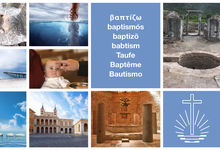The sacraments (50): Baptism in two parts
When asked how a Christian receives the Holy Spirit, the New Apostolic Church’s answer to the question is: through Holy Sealing. Our sacramental understanding and its points of reference in the Bible and in church history are detailed below.

The New Apostolic sacraments have their source in the life and activity of Jesus Christ. This does not only apply to Holy Baptism and Holy Communion, but also to Holy Sealing.
Water baptism and baptism with the Spirit
Both John 1: 29–34 as well as Matthew 3: 16 report that after Jesus’ baptism the Spirit of God descended upon Him. That Holy Sealing finds its model there is also due to Acts 10: 37–38, which refers to “how God anointed Jesus of Nazareth with the Holy Spirit and with power”.
The Catechism of the New Apostolic Church justifies the division of the rebirth with water and the Spirit into the two sacraments by saying that “two distinct acts can be identified” (CNAC 8.3.3) at the event by the Jordan River. The various accounts in Acts also make it clear that the gift of the Holy Spirit was given after the baptism with water was complete.
The constituent elements of the sacraments
All sacraments follow a common blueprint comprised of the four cornerstones of faith, dispenser, sign, and content, and are defined as follows in the case of Holy Sealing:
- Holy Sealing requires that those who receive it—parents for children—believe in the triune God and the Apostles sent by Jesus Christ. Prior to this the recipient must have been baptised with water in the proper manner (CNAC 8.3.7).
- The sacraments are exclusively dispensed by Apostles. According to the testimony of Scripture, Holy Sealing is bound to the Apostle ministry (CNAC 8.3.5).
- According to the Bible, the visible sign is the gesture of laying on of hands of the Apostle. The prayer of the Apostle is also part of the proper dispensation of the sacrament (CNAC 8.3.6). Anointing oil is not used, as it is not mentioned in the early Christian accounts.
- The content of the sacrament is always the act of God: the human being is filled with the Holy Spirit, with power from God. That which was begun in Holy Baptism is completed in Holy Sealing, namely the rebirth out of water and Spirit. The effects are childhood in God as well as the calling to be a firstling (CNAC 8.3.8/8.3.9).
“In this sense, childhood in God thus refers to that condition of a human being before God which is characterised by having received all the sacraments, believing in the proper proclamation of the gospel, and aligning one’s life by the return of Christ,” the Catechism says. “Firstlings” is the term used to describe all those whom Jesus Christ will take with Him at His return. It is identical with the bridal congregation (CNAC 10.1.3).
However, the human being has already been incorporated into the body, or rather into the church of Christ, through Holy Baptism. For Holy Baptism with water performed in the name of the Trinity is a binding element among Christians (CNAC 8.1.6).
Chrismation, confirmation, sealing
The path to Christian maturity goes through various stages. This process is something that the Catholic and Orthodox Churches also know, who according to membership figures account for a good 70 per cent of Christians worldwide:
- Orthodox Churches admit children with a three-step ceremony: baptism with water, Chrismation (an anointing with oil), and Communion. While baptism allows the believer to participate in the death and resurrection of Christ, the act of Chrismation allows the believer to share in the delivery of the Holy Spirit at Pentecost. Thus the baptised person becomes a lay person—a member of the laós, the people of God.
- In the Catholic Churches it is confirmation that lends the fullness of the Holy Spirit. “Confirmation perfects baptismal grace”, and “is to root the believers more deeply in the divine filiation”. The administration of the sacrament is bound to the episcopate. The recipients are adults, if possible directly after baptism; or children, long after baptism, as soon as they have reached the age of reason.
The term “sealing”, used to describe the sacrament that imparts the Holy Spirit, is borrowed from the Catholic Apostolic Church. Its understanding of the apostolic laying on of hands as a confirmation of baptism, however, developed early on in the still emerging New Apostolic Church and in the direction we know today.
Photo: adragan - stock.adobe.com
Article info
Author:
Date:
Keywords:
Andreas Rother
15.02.2022
sacraments,
Holy Sealing,
Doctrinal statements
















